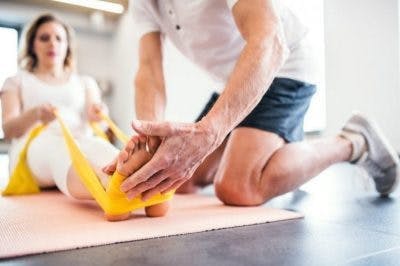Learning to Walk Again Due to Neuroplasticity
Walking after encephalon injury is a common recovery goal during physical therapy. Many traumatic brain injury survivors are eager to improve their gait, or manner of walking, to regain independence and feel confident with the activities of daily living again.
To help you regain the ability to walk on your own, this guide will explain some of the challenges when learning to walk once again after a traumatic brain injury (TBI) along with the steps y'all can take to meliorate your gait.
Table of contents
- Why can a brain injury touch walking skills?
- How can I railroad train my brain to walk again?
- Rehab exercises to walk again after brain injury
Why Can a Brain Injury Touch on Walking Skills?
In that location are several reasons why a brain injury can affect a person's gait, or ability to walk. Some common causes of gait changes include:
- Residuum issues.Between 30% and 65% of traumatic brain injury survivors struggle with remainder issues. These can stem from a range of issues including musculus weakness, inner ear impairment, and damage to the cerebellum, which plays a role in maintaining balance.
- Primary motor cortex damage.The primary motor cortex is likewise responsible for the coordination of muscle movements. If a brain injury damages this area, then activities that involve multiple musculus groups, like walking, tin get dumb.
- Spasticity.When a brain injury disrupts the connexion between the brain and the muscles, the encephalon can no longer send signals to the muscles telling them when to contract. As a result, spasticity and muscle tightness can set in, making walking after brain injury much more hard.
With such a diversity of unlike causes of poor gait after brain injury, information technology's important for brain injury survivors to piece of work closely with their therapists to diagnose and rehabilitate their walking abilities.
How Can I Railroad train My Brain to Walk Again?
Walking after brain injury involves retraining the encephalon to command the muscles involved in walking. This is possible thanks to neuroplasticity.
Neuroplasticity is the encephalon's ability to rewire and reorganize itself. After a brain injury, neuroplasticity allows the brain to compensate for the damage. Although damaged brain cells cannot regenerate, neuroplasticity allows salubrious areas of the brain to take on impaired functions.
For instance, if a brain injury afflicted the cerebellum, the part of residuum can get impaired. Through neuroplasticity, the function of remainder can be rewired to healthy areas of the encephalon. It does not happen on its ain, though.
Neuroplasticity occurs through repetition and consistency. The brain likes to be efficient, then it will create and strengthen neural pathways for activities that are adept regularly.
During gait rehabilitation after TBI, survivors practice therapeutic movements involved in walking. Depending on the problem area, the individual may practice leg or balance exercises. When these exercises are practiced with high repetition, information technology stimulates neuroplasticity and encourages the brain to amend efficiency of those movements.
To put it simply, an individual with encephalon injury tin can train their brain to walk again through repetitive practice of gait rehabilitation exercises.
Rehab Exercises to Walk Again After Brain Injury
Rehab exercises are a disquisitional step towards regaining the ability to walk. It's important to work with your therapists to create a custom rehabilitation regimen that caters to your unique needs.
Up next, nosotros volition discuss some common rehabilitation techniques that your therapist may advise.
ane. Passive Rehab Exercises
Individuals that have experienced a astringent brain injury may have no movement in their legs and therefore cannot walk. This often means they rely on wheelchairs to get around instead of other less-restricting devices similar a cane.
Fortunately, it is yet possible to regain musculus movement and walking skills even if you lot have limited leg function. Y'all tin can do this through passive exercise, which involves assisting your legs through targeted movements, rather than moving with your legs' muscle power alone.
Passive exercise helps stimulate the brain and actuate neuroplasticity, especially when attention is paid to the movement. Focusing on and mentally visualizing the body completing a movement increases associated encephalon activation, optimizing neuroplasticity.
A therapist or trained caregiver tin help a TBI survivor achieve these passive exercises that target the legs, or the survivor may learn how to complete the exercises independently using their upper trunk to assist.
Passive techniques are a nifty place to begin learning how to walk over again after brain injury. With fourth dimension and practice, individuals may slowly regain motility in the legs; at which point they tin can motion onto agile exercises.
2. Leg Exercises
Perhaps the almost obvious rehab exercises to walk over again after brain injury are exercises that target movement and strength of the legs. Walking is a total-trunk activity, and the legs play a large role.
Practicing rehab exercises that target the legs will assist retrain the brain to use the legs with increasing coordination. As movements become more coordinated, individuals can also focus on strengthening the legs through exercise.
Some examples of leg exercises for gait rehabilitation include:
- Seated marching.Start in a seated position. Lift your affected leg up toward your chest, concord for 1 second, then slowly let it down. Echo on the other leg. If this is also hard, you can exercise this exercise passively past using your arms to assistance your legs.
- Human knee extension. Sit on a stool or chair. Side by side, extend your knee as far out as you tin. So slowly bring your foot to the flooring. Repeat on the other leg.
Although some leg exercises may seem to be just addressing movement, information technology is of import to remember that you tin build strength by lifting only your own body weight, rather than always having to rely on additional weights.
Every bit with all rehab do, high repetition and consistency are primal to rewiring the brain and improving movement after brain injury.
three. Pes Drop Exercises

Pes drop is a mutual challenge following TBI that impairsdorsiflexion of the ankle, which involves your ability to elevator the front of the human foot upwards towards the shin. Difficulty with dorsiflexion tin can make activities, such equally walking or climbing stairs, afterward brain injury nearly impossible. Therefore, improving dorsiflexion is critical for relearning to walk after brain injury. You lot can do this through human foot drop exercises.
Some of the best human foot drop exercises include:
- Passive ankle dorsiflexion.Sit down in a comfortable position and cantankerous one leg over your other. Then, use your manus to motility your foot up towards your articulatio genus and dorsum down. Repeat ten times, then switch to your other pes. This exercise is great for patients who have weak or paralyzed ankle muscles.
- Assisted toe raises. If you tin can only movement 1 human foot, this practise can help y'all strengthen your other ankle. First, identify your stiff foot underneath your affected one. Then, utilise your practiced human foot to lift upwards your weak foot. Brand sure you keep your heel on the ground at all times. Finally, lower the pes back down. Repeat x times.
One time you lot have improved strength and coordination in your legs and feet, you lot can move on to the next stage of relearning how to walk after brain injury: weight bearing.
4. Weight Begetting Exercise
Weight begetting exercises assist your legs and cadre muscles relearn how to concur your body upright.
Some great weight bearing exercises include "sit to stands" where you exercise going from a seated position to continuing. You can also do some weight shifting where yous put most of your weight on 1 leg then motion to the other.
In that location are even ways to exercise weight bearing without putting your full body weight onto your legs. These can exist great methods to slowly build strength in the legs and conviction with walking, while frequently minimizing the adventure of falling. Some fractional weight bearing options include:
- Using parallel bars: your arms are able to support some of your body weight
- Practicing aquatic therapy: the buoyancy of water makes you lot "lighter" than on country
- Using a torso weight support organization (such every bit a specialized harness fastened to an overhead track)
Be sure to check with your therapist before attempting any exercises without recommended assistive devices such as walkers or canes.
When your body has gotten used to weight bearing over again, you can finally motility on to improving your balance.
5. Remainder Exercises
Balance is crucial for both walking and standing, and rehab exercises that help with residual are an important part of any gait rehabilitation plan.
Many leg and core exercises naturally help with balance because they help increase the coordination necessary for remainder.
six. Motivating Exercises
If you struggle with practicing your rehab exercises with enough repetition and consistency, and then y'all can attempt motivating habitation therapy devices like FitMi.

FitMi helps encephalon injury survivors regain the ability to walk by encouraging high repetition of total-body rehab exercises. Unlike written sheets of exercises, which can grow boring and wearisome, FitMi creates an interactive abode therapy experience. Users collaborate with the blueish and yellowish "pucks" (by gripping, pressing, or stomping, for example) to practice therapeutic exercises.
FitMi is also adaptive and unlocks more than difficult exercises as you improve. Earlier every session, yous can cull which muscles groups you desire to work on, including the legs and core, which help target the areas necessary for walking.
7. Vestibular/Vision Therapy
Sometimes residue issues stem from inner ear or vision issues, which may require a different approach to treatment. In these cases, vestibular therapy and/or vision therapy tin often treat these issues and help y'all regain your rest once again.
8. Task-Specific Gait Training
Individuals that take enough move to walk with assistive devices, such as walkers or canes, can as well do good from task-specific preparation, which but involves walking.
Walking provides nifty stimulation to the brain and helps you practice the very action that you want to improve. Individuals should practise care and caution when attempting this step, though.
Every bit your walking skills meliorate, y'all may progress to more difficult walking tasks, such as walking on uneven surfaces or up and down stairs.
Never abandon assistive devices without a green light from your therapist. If y'all rely on a walker or four-signal cane, it can be unsafe to abandon these devices and attempt to walk on your ain.
Individuals with dumb gait are at a greater take chances of falling, which tin set back your recovery. Accept groovy care with yourself and use any devices recommended by your therapist.
9. Intensive Mobility Gait Grooming
The last step in learning to walk over again isintensive mobility gait training.
This type of gait preparation includes an aerobic aspect, where you will continuously perform a movement at moderate intensity.
Some examples of this training include riding a stationary cycle or repeatedly continuing up and sitting down — annihilation that gets your heart pumping.
The goal of intensive mobility training is to increase your endurance so that you can walk without tiring out too quickly.
Relearning to Walk After Brain Injury
As you make your way through all of these steps, your gait should slowly better as you stimulate the brain and spark neuroplasticity. Walking after encephalon injury can be a long and difficult procedure, but it is achievable with difficult work and dedication.
Be sure to work closely with your therapist, who can recommend exercises you lot can practice at home. You lot can also motivate yourself with interactive calm therapy programs like FitMi, which is therapist-approved. We hope these steps assist yous get dorsum on your feet with confidence.
Source: https://www.flintrehab.com/walking-after-brain-injury/
0 Response to "Learning to Walk Again Due to Neuroplasticity"
Post a Comment